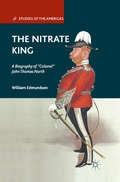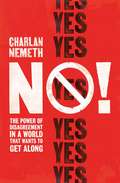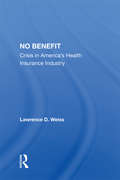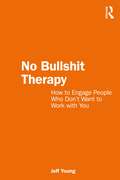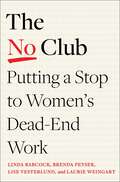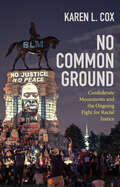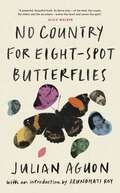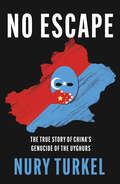- Table View
- List View
The Nitrate King: A Biography of “Colonel” John Thomas North (Studies of the Americas)
by W. EdmundsonWilliam Edmundson examines the spectacular life story of 'Colonel' John Thomas North, also known as 'The Nitrate King,' a mechanic in Leeds who became one of the best-known and richest men of his time. Forgotten in Britain and vilified in Chile and Peru, this is the first biography of a controversial but compelling figure.
NL ARMS Netherlands Annual Review of Military Studies 2018: Coastal Border Control: From Data and Tasks to Deployment and Law Enforcement (NL ARMS)
by H. Monsuur J. M. Jansen F. J. MarchalThis book provides a comprehensive study of border control: from data analysis andinformation warfare, frameworks for command and control, and game-theoretic riskmanagement, up to the (optimal) deployment of law enforcement missions.Innovative about this book is that it approaches the subject from several angles, aimingto connect theory and practice of law enforcement missions with risk management and/or quantitative modelling. Some chapters focus on legal challenges and informationwarfare, while others provide quantitative modelling of military asset deployment inthe area of interest, or show the benefits of cooperative wireless sensor networks forborder control. A case study of the Dutch Border Security Team supplements the theory.The publication is ideally suited for reference use by students, academicians, researchersand professionals in the field of border control and related areas.H. Monsuur is Professor of Military Operations Research, J.M. Jansen is AssociateProfessor of Operational ICT, and F.J. Marchal is Lecturer of International/MilitaryLaw at the Faculty of Military Sciences of the Netherlands Defence Academy in DenHelder, The Netherlands.
NMR: Principles and Applications to Biomedical Research
by Jay W. PettegrewNuclear magnetic resonance (NMR) is having an enormous liTIpact on biomedical research both at the basic science and clinical levels. In order to appreciate the elegance and power of this technology a historical perspective is in order. In 1924 Pauli suggested that hydrogen nuclei might possess a magnetic IIlOlllent. This was in fact confinned by Rabbi in 1939 who demonstrated that a beam of hydrogen molecules in the presence of a magnetic field could be mutated by radio frequency fields resonating at the Iarmor frequency. 'Ihe first successful NMR experiments in condensed matter were independently conducted in late 1945 by Purcell, Torrey and PoUnd and by Bloch, Hansen and Packard. 'Ihe Purcell group detected proton NMR in solid paraffin and the Bloch group detected proton in liquid water. Bloch and Purcell received the Nobel Prize in physics in 1952 for these observations . Until about 1952, studies of liquids and solids with broad resonance lines dominated the field of NMR. However, the reports of 3 1 P NMR chemical shifts in several corrpounds in 1949 by Khight, of 14 N resonances in several ions by Proctor and Yu in 1950, and of 1 9 F resonances in several corrpounds in 1950 by Dickinson led to the development of high resolution NMR in Itquids. since the molecular motions in liquids result in very narrow lines compared to those in solids, :much smaller chemical shifts could be detected.
No!: The Power of Disagreement in a World that Wants to Get Along
by Charlan NemethWe like to get along, at home or in the workplace. We don't want to hurt people or offend. Therefore, it is no surprise that numerous famous psychological experiments have proven that we don't tend to go against authority or the majority view. Famous management gurus share the view that harmony, cohesiveness and agreement are the building blocks for effective decision-making and creativity. But they are wrong.In No!, Charlan Nemeth, the world's leading expert on dissent, uses her 35 years of research to show why we need rebels - and how fostering more disagreement can dramatically improve decisions and the production of good ideas. Using examples from Twelve Angry Men to brainstorming, she explains how people with minority opinions need the space to express themselves uncompromisingly, even if it causes discomfort. Explaining why the devil's advocate technique doesn't work and why authentic disagreement is necessary to open our perspectives, this book has the power to revolutionise business, creative organisations, and society.
No. 1 Mum: A Celebration of Motherhood
by Alison MaloneyFor No. 1 Mums everywhere, this is the perfect celebration of motherhood, filled with inventive ideas and clever tips and bubbling with joyful things. From chicken soup to Sunday roasts, bubble bath to balloons, No. 1 Mum pays tribute to the top 100 objects every mother will recognise, in a fun and handy book that promises to amuse and inspire in equal measure. Along the way, Alison offers great ideas to complement the objects – top-ten ideas for travel games to play, a birthday cake recipe that will wow your child’s friends, the perfect solution to the thorny school play costume dilemma – in an entertaining and rewarding celebration of motherhood.
No Accident, Comrade: Chance and Design in Cold War American Narratives
by Steven BellettoNo Accident, Comrade argues that chance became a complex yet conflicted cultural signifier during the Cold War, when a range of thinkers--politicians, novelists, historians, biologists, sociologists, and others--contended that totalitarianism denied the very existence and operation of chance in the world. They claimed that the USSR perpetrated a vast fiction on its population, a fiction amplified by the Soviet view that there is no such thing as chance or accident, only manifestations of historical law (hence the popular American refrain used to refer to Marxism: "It was no accident, Comrade"). By reading an expansive range of American novels published between 1947-2005, alongside nonfiction texts by the likes of Jerzy Kosinski, Daniel Bell, Ian Hacking, and mid-century game theorists, No Accident, Comrade explains how associations of chance with democratic freedom and the denial of chance with totalitarianism circulated in Cold War America. Chance became tied to the liberties of U.S. democracy, whereas its eradication or denial became symptomatic of Soviet tyranny. With works by Nabokov, Ellison, Pynchon, Didion, DeLillo, Colson Whitehead, and many others, Steven Belletto shows how writers developed innovative strategies for dealing with and incorporating these ever-present beliefs about chance and its role in their culture. These newly developed narrative techniques allowed them to theorize, satirize, and make sense of the constantly changing relationship between the individual and the state during a largely rhetorical conflict.
No Benefit: Crisis In America's Health Insurance Industry
by Lawrence D. WeissThe private health insurance industry is unable to provide nearly 40 million Americans with basic health care. Relying on data from a wide range of publications about this secretive industry, Lawrence D. Weiss investigates the causes of the industry's problems and analyzes the social effects of the growing crisis. The causes include excessive overhead costs, widespread inefficiency, and exemptions from antimonopoly regulations; the social effects include small businesses' inabilities to provide adequate coverage for their employees, the reluctance of many carriers to insure certain social groups, and the disproportionate burden on minorities. Addressing these dilemmas, Lawrence D. Weiss offers a timely and important analysis of the health insurance crisis in America.
No Benefit: Crisis In America's Health Insurance Industry
by Lawrence D. WeissThe private health insurance industry is unable to provide nearly 40 million Americans with basic health care. Relying on data from a wide range of publications about this secretive industry, Lawrence D. Weiss investigates the causes of the industry's problems and analyzes the social effects of the growing crisis. The causes include excessive overhead costs, widespread inefficiency, and exemptions from antimonopoly regulations; the social effects include small businesses' inabilities to provide adequate coverage for their employees, the reluctance of many carriers to insure certain social groups, and the disproportionate burden on minorities. Addressing these dilemmas, Lawrence D. Weiss offers a timely and important analysis of the health insurance crisis in America.
No Billionaire Left Behind: Satirical Activism in America
by Angelique HaugerudGrowing economic inequality, corporate influence in politics, an eroding middle class. Many Americans leave it to politicians and the media to debate these topics in the public sphere. Yet other seemingly ordinary Americans have decided to enter the conversation of wealth in America by donning ball gowns, tiaras, tuxedos, and top hats and taking on the imagined roles of wealthy, powerful, and completely fictional characters. Why? In No Billionaire Left Behind, Angelique Haugerud, who embedded herself within the "Billionaires" and was granted the name "Ivana Itall," explores the inner workings of these faux billionaires and mines the depths of democracy's relationship to political humor, satire, and irony. No Billionaire Left Behind is a compelling investigation into how satirical activists tackle two of the most contentious topics in contemporary American political culture: the increasingly profound division of wealth in America, and the role of big money in electoral politics. Anthropologist and author Angelique Haugerud deftly charts the evolution of a group named the Billionaires—a prominent network of satirists and activists who make a mockery of wealth in America—along with other satirical groups and figures to puzzle out their impact on politics and public opinion. In the spirit of popular programs like The Colbert Report and The Daily Show, the Billionaires demonstrate a sophisticated knowledge of economics and public affairs through the lens of satire and humor. Through participant observation, interviews, and archival research, Haugerud provides the first ethnographic study of the power and limitations of this evolving form of political organizing in this witty exploration of one group's efforts to raise hope and inspire action in America's current political climate.
No Borders: The Politics of Immigration Control and Resistance
by Natasha KingFrom the streets of Calais to the borders of Melilla, Evros and the United States, the slogan 'No borders!' is a thread connecting a multitude of different struggles for the freedom to move and to stay. But what does it mean to make this slogan a reality?Drawing on the author's extensive research in Greece and Calais, as well as a decade campaigning for migrant rights, Natasha King explores the different forms of activism that have emerged in the struggle against border controls, and the dilemmas these activists face in translating their principles into practice.Wide-ranging and interdisciplinary, No Borders constitutes vital reading for anyone interested in how we make radical alternatives to the state a genuine possibility for our times, and raises crucial questions on the nature of resistance.
No Borders: The Politics of Immigration Control and Resistance
by Natasha KingFrom the streets of Calais to the borders of Melilla, Evros and the United States, the slogan 'No borders!' is a thread connecting a multitude of different struggles for the freedom to move and to stay. But what does it mean to make this slogan a reality?Drawing on the author's extensive research in Greece and Calais, as well as a decade campaigning for migrant rights, Natasha King explores the different forms of activism that have emerged in the struggle against border controls, and the dilemmas these activists face in translating their principles into practice.Wide-ranging and interdisciplinary, No Borders constitutes vital reading for anyone interested in how we make radical alternatives to the state a genuine possibility for our times, and raises crucial questions on the nature of resistance.
No Boundary: Eastern and Western Approaches to Personal Growth (PDF)
by Ken WilberA simple yet comprehensive guide to the types of psychologies and therapies available from Eastern and Western sources. Each chapter includes a specific exercise designed to help the reader understand the nature and practice of the specific therapies. Wilber presents an easy-to-use map of human consciousness against which the various therapies are introduced and explained. This edition includes a new preface.
No Boundary: Eastern and Western Approaches to Personal Growth
by Ken WilberA simple yet comprehensive guide to the types of psychologies and therapies available from Eastern and Western sources. Each chapter includes a specific exercise designed to help the reader understand the nature and practice of the specific therapies. Wilber presents an easy-to-use map of human consciousness against which the various therapies are introduced and explained. This edition includes a new preface.
No Bullshit Therapy: How to engage people who don’t want to work with you
by Jeff YoungDo you have clients who do not want to be helped? Clients who don’t trust you, your profession, or your service? Clients who don’t want to change despite your best efforts? Then No Bullshit Therapy (NBT) is for you! Most simply, NBT is about being authentic. Many people are cajoled, pressured, or mandated to see therapists, counsellors, and other helpers. Hence, they are reluctant, suspicious, and resistant to being helped. This puts professionals in the difficult position of trying to help someone who does not want to be helped. To make things worse, there are few practice models designed to engage people who don’t want to be engaged. NBT creates a context for mutual honesty and directness in working relationships. Creating a context for mutual honesty and directness can be refreshingly effective, especially with people who are suspicious of counselling or distrustful of the counsellor. When combined with warmth and care, honesty and directness can enhance co-operation, connection, and trust, especially if the practitioner avoids jargon and acknowledges constraints to the work. NBT is ideal for working with people who: • Don’t like therapy or the idea of therapy (even if they’ve never had it) • Don’t trust warm fuzzy “do-gooders” or “psychologisers” • Are suspicious of services because they have experienced trauma and have had abusive institutional experiences or unsatisfactory treatment in the past • Don’t see themselves as a client, don’t agree with the referrer’s description of them or their problems, and appear to not want to change Practical and engaging, this book is an essential guide for therapists, counsellors, and other allied-health professionals who are looking for a more effective way to connect with reluctant clients and ensure they get the support they need. It may also help you create more robust relationships at work and at home.
No Bullshit Therapy: How to engage people who don’t want to work with you
by Jeff YoungDo you have clients who do not want to be helped? Clients who don’t trust you, your profession, or your service? Clients who don’t want to change despite your best efforts? Then No Bullshit Therapy (NBT) is for you! Most simply, NBT is about being authentic. Many people are cajoled, pressured, or mandated to see therapists, counsellors, and other helpers. Hence, they are reluctant, suspicious, and resistant to being helped. This puts professionals in the difficult position of trying to help someone who does not want to be helped. To make things worse, there are few practice models designed to engage people who don’t want to be engaged. NBT creates a context for mutual honesty and directness in working relationships. Creating a context for mutual honesty and directness can be refreshingly effective, especially with people who are suspicious of counselling or distrustful of the counsellor. When combined with warmth and care, honesty and directness can enhance co-operation, connection, and trust, especially if the practitioner avoids jargon and acknowledges constraints to the work. NBT is ideal for working with people who: • Don’t like therapy or the idea of therapy (even if they’ve never had it) • Don’t trust warm fuzzy “do-gooders” or “psychologisers” • Are suspicious of services because they have experienced trauma and have had abusive institutional experiences or unsatisfactory treatment in the past • Don’t see themselves as a client, don’t agree with the referrer’s description of them or their problems, and appear to not want to change Practical and engaging, this book is an essential guide for therapists, counsellors, and other allied-health professionals who are looking for a more effective way to connect with reluctant clients and ensure they get the support they need. It may also help you create more robust relationships at work and at home.
No Choice: The Fall of Roe v. Wade and the Fight to Protect the Right to Abortion
by Becca Andrews'Powerful, deftly researched. A necessary and urgent deep-dive' ELINOR CLEGHORN'Brilliantly researched and enlightening' STYLIST, Books You Need to Know This Autumn'Absolutely captivating' LESLIE JAMISON----------------------------------------------------------------------------------------------On Friday 24 June 2022, women's rights suffered an extraordinary and unprecedented blow. Five US Supreme Court justices made a decision that will impact millions of lives for years to come.In this gripping blend of reportage and history, journalist Becca Andrews tells the story how we have arrived at this devastating turning point.NO CHOICE introduces the origin of abortion and its practice in global cultures, before focusing its gaze on the battle that has been waged for the past century across America, shining a light on the eerie ways in which life before Roe will be mirrored in life after. The wealthy and privileged will still have access, low-income people will suffer disproportionately, and pregnancy will be heavily policed.Taking us to the frontlines - to clinics, courtrooms, local communities, charities - Andrews tells the deeply moving stories of those who have had abortions, and those who have fought - and are fighting - for the right to abortion. There is a glimmer of faint hope, though. As the battle moves to state legislatures around the country, the book profiles the people who are doing ground-breaking, inspiring work to ensure safe, legal access to this fundamental part of healthcare.
No Citizen Left Behind (Educational psychology: critical pedagogical perspectives ; #13)
by Meira LevinsonWhile teaching at an all-Black middle school in Atlanta, Levinson realized that her students’ individual self-improvement would not necessarily enable them to overcome their historical marginalization. In order to overcome their civic empowerment gap, students must learn how to reshape power relationships through public political and civic action.
No Citizen Left Behind (Educational psychology: critical pedagogical perspectives ; #13)
by Meira LevinsonWhile teaching at an all-Black middle school in Atlanta, Levinson realized that her students’ individual self-improvement would not necessarily enable them to overcome their historical marginalization. In order to overcome their civic empowerment gap, students must learn how to reshape power relationships through public political and civic action.
The No Club: Putting a Stop to Women’s Dead-End Work
by Linda Babcock Brenda Peyser Lise Vesterlund Laurie R. WeingartA practical guide for bringing gender equality to the workplace with a new imperative: unburden women's careers from work that goes unrewarded.THE NO CLUB started when four women who were crushed by endless to-do lists banded together over $10 bottles of wine and vowed to get their work lives under control. Running faster than ever, they nevertheless trailed behind their male colleagues. And so, they vowed to say no to requests that pulled them away from the work that mattered most to their careers. This book reveals how their over-a-decade-long journey and groundbreaking research uncovered that women everywhere are unfairly burdened with "non-promotable work", a tremendous problem we can - and must - solve.All organizations have work that no one wants to do: planning the office party, screening interns, attending to that time-consuming client, or simply helping others with their work. From office housework to important assignments that inevitably go unrewarded, a woman, most often, takes on these tasks. In study upon study, professors Linda Babcock (bestselling author of WHY WOMEN DON'T ASK), Brenda Peyser, Lise Vesterlund, and Laurie Weingart - the original "No Club" - document that women are disproportionately asked and expected to do this kind of work. This imbalance leaves women overcommitted and underutilized as companies forfeit revenue, productivity, and top talent.But it doesn't have to be this way. THE NO CLUB walks you through how to make small, yet important, changes to your own workload and empowers women to make savvy decisions about what they take on. At the same time, the authors illuminate how lasting change calls for organizations to reassess how they assign and reward work to level the playing field. With hard data, personal anecdotes from women of all stripes, practical self- and workplace-assessments, and innovative advice from consulting in Fortune 500 companies, this book will forever change the conversation about how we advance women's careers and achieve equality in the twenty-first century.
No Common Ground: Confederate Monuments and the Ongoing Fight for Racial Justice (A Ferris and Ferris Book)
by Karen L. CoxWhen it comes to Confederate monuments, there is no common ground. Polarizing debates over their meaning have intensified into legislative maneuvering to preserve the statues, legal battles to remove them, and rowdy crowds taking matters into their own hands. These conflicts have raged for well over a century--but they've never been as intense as they are today. In this eye-opening narrative of the efforts to raise, preserve, protest, and remove Confederate monuments, Karen L. Cox depicts what these statues meant to those who erected them and how a movement arose to force a reckoning. She lucidly shows the forces that drove white southerners to construct beacons of white supremacy, as well as the ways that antimonument sentiment, largely stifled during the Jim Crow era, returned with the civil rights movement and gathered momentum in the decades after the Voting Rights Act of 1965. Monument defenders responded with gerrymandering and "heritage" laws intended to block efforts to remove these statues, but hard as they worked to preserve the Lost Cause vision of southern history, civil rights activists, Black elected officials, and movements of ordinary people fought harder to take the story back. Timely, accessible, and essential, No Common Ground is the story of the seemingly invincible stone sentinels that are just beginning to fall from their pedestals.
No Country for Eight-Spot Butterflies: With an introduction by Arundhati Roy
by Julian Aguon'A powerful, beautiful book. Its fierce love - of the land, the ocean, the elders and the ancestors - warms the heart and moves the spirit.' - Alice Walker, author of The Color PurplePart memoir, part manifesto, Chamorro climate activist Julian Aguon's No Country for Eight-Spot Butterflies is a coming-of-age story and a call for justice-for everyone, but in particular, for Indigenous peoples.Aguon beautifully weaves together stories from his childhood in the villages of Guam with searing political commentary about matters ranging from nuclear weapons to global warming. Bearing witness and reckoning with the challenges of truth-telling in an era of rampant obfuscation, he culls from his own life experiences to illuminate a collective path out of the darkness.A powerful and bold new voice writing at the intersection of Indigenous rights and environmental justice, Aguon is entrenched in the struggles of the people of the Pacific who are fighting to liberate themselves from colonial rule, defend their sacred sites and obtain justice for generations of harm.In No Country for Eight-Spot Butterflies, Aguon shares his wisdom and reflections on love, grief, joy and triumph, and extends an offer to join him in a hard-earned hope for a better world.
No Duty to Retreat: Violence and Values in American History and Society
by Richard Maxwell BrownIn 1865, Wild Bill Hickok killed Dave Tutt in a Missouri public square in the West's first notable "walkdown." One hundred and twenty-nine years later, Bernhard Goetz shot four threatening young men in a New York subway car. Apart from gunfire, what could the two events possibly have in common? Goetz, writes Richard Maxwell Brown, was acquitted of wrongdoing in the spirit of a uniquely American view of self-defense, a view forged in frontier gunfights like Hickok's. When faced with a deadly threat, we have the right to stand our ground and fight. We have no duty to retreat. No Duty to Retreat offers an engrossing account of how this idea of self-defense emerged, focusing in particular on the gunfights of the frontier and their impact on our legal traditions. The right to stand one's ground, Brown tells us, appeared relatively recently. Under English common law, the threatened party had a legal duty to retreat "to the wall" before fighting back. But from the nineteenth century on, such authorities as Justice Oliver Wendell Holmes rejected this doctrine as unsuited to both the American mind and the age of firearms. Brown sketches the influence of frontier violence, demonstrating the tremendous impact of the famous gunmen and the prevalence of what he calls "grassroots gunfighters"--unsung men who resorted to their guns at a moment's notice. These duels, ambushes, and firefights, he writes, were more than personal vendettas: They were part of a "Western Civil War of Incorporation," pitting gunmen--usually Republicans and Unionists, who sided with the expanding banks, railroads, and businesses--against cowboys and independent farmers, who were often Democrats sympathizing with the Confederacy. Brown examines the gunfight near the O.K. Corral in this light, showing how it was a climax of tensions between Tombstone's Republican businessmen (represented by Wyatt Earp) and the county's cowboys (led by the Clantons and McLaurys). He also looks at such lesser-known battles as the Mussel Slough war, in which resisting farmers, imbued with the no-retreat ethic, fought for their independent lifestyle against encroaching rail barons. This Civil War of Incorporation fed the violence of the West and reinforced the legal doctrine of "no duty to retreat." The frontier days are long past, but Brown shows how the ethic of no retreat continues to shape everything from our entertainment to our foreign policy (including President Bush's "line drawn in the sand") to our politics to cases like that of Bernhard Goetz. Though challenged as never before by the values of peace and social activism, it remains a central theme in American thought and character.
No Duty to Retreat: Violence and Values in American History and Society
by Richard Maxwell BrownIn 1865, Wild Bill Hickok killed Dave Tutt in a Missouri public square in the West's first notable "walkdown." One hundred and twenty-nine years later, Bernhard Goetz shot four threatening young men in a New York subway car. Apart from gunfire, what could the two events possibly have in common? Goetz, writes Richard Maxwell Brown, was acquitted of wrongdoing in the spirit of a uniquely American view of self-defense, a view forged in frontier gunfights like Hickok's. When faced with a deadly threat, we have the right to stand our ground and fight. We have no duty to retreat. No Duty to Retreat offers an engrossing account of how this idea of self-defense emerged, focusing in particular on the gunfights of the frontier and their impact on our legal traditions. The right to stand one's ground, Brown tells us, appeared relatively recently. Under English common law, the threatened party had a legal duty to retreat "to the wall" before fighting back. But from the nineteenth century on, such authorities as Justice Oliver Wendell Holmes rejected this doctrine as unsuited to both the American mind and the age of firearms. Brown sketches the influence of frontier violence, demonstrating the tremendous impact of the famous gunmen and the prevalence of what he calls "grassroots gunfighters"--unsung men who resorted to their guns at a moment's notice. These duels, ambushes, and firefights, he writes, were more than personal vendettas: They were part of a "Western Civil War of Incorporation," pitting gunmen--usually Republicans and Unionists, who sided with the expanding banks, railroads, and businesses--against cowboys and independent farmers, who were often Democrats sympathizing with the Confederacy. Brown examines the gunfight near the O.K. Corral in this light, showing how it was a climax of tensions between Tombstone's Republican businessmen (represented by Wyatt Earp) and the county's cowboys (led by the Clantons and McLaurys). He also looks at such lesser-known battles as the Mussel Slough war, in which resisting farmers, imbued with the no-retreat ethic, fought for their independent lifestyle against encroaching rail barons. This Civil War of Incorporation fed the violence of the West and reinforced the legal doctrine of "no duty to retreat." The frontier days are long past, but Brown shows how the ethic of no retreat continues to shape everything from our entertainment to our foreign policy (including President Bush's "line drawn in the sand") to our politics to cases like that of Bernhard Goetz. Though challenged as never before by the values of peace and social activism, it remains a central theme in American thought and character.
No Escape: The True Story Of China's Genocide Of The Uyghurs
by Nury Turkel‘No Escape is what the world needs to read’ Nathan Law, Nobel Peace Prize nominee A devastating account of China’s genocide of the Uyghurs, by a leading Uyghur activist and Time #100 nominee
